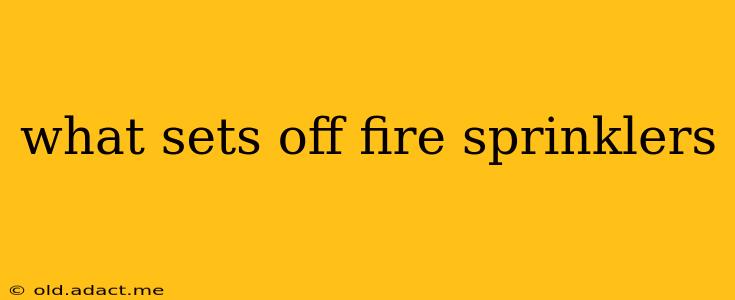What Sets Off Fire Sprinklers? Understanding the Mechanics of Fire Suppression
Fire sprinklers are crucial life-saving devices designed to protect lives and property from the devastating effects of fire. But what exactly sets them off? It's not just heat; it's a sophisticated system triggered by a specific combination of factors, ensuring they only activate when necessary. This article delves into the mechanisms behind fire sprinkler activation, addressing common questions and misconceptions.
What temperature do fire sprinklers activate at?
This is a common question, and the answer isn't a single number. Sprinklers are designed with varying activation temperatures, typically ranging from 135°F (57°C) to 200°F (93°C), depending on the application and the anticipated fire hazards. Lower-temperature sprinklers are used in areas where a faster response is critical, such as those containing sensitive materials or where rapid fire spread is likely. Higher-temperature sprinklers are often found in areas with less risk of immediate fire spread. The specific temperature rating is clearly marked on each sprinkler head.
Is it only heat that activates fire sprinklers?
While heat is the primary trigger, it's not simply ambient air temperature. Sprinklers utilize a heat-sensitive element, often a glass bulb or a fusible link, that melts or breaks at a specific temperature. This mechanism releases the sprinkler's internal mechanism, allowing water to flow. The design prevents accidental activation from minor temperature fluctuations. The heat must be concentrated enough and sustained long enough to activate the heat-sensitive element.
What kind of heat activates a sprinkler?
The heat required is radiant heat from the fire itself. This is crucial because it ensures that the sprinkler will only activate when a significant fire is present, not from ambient heat from other sources like sunlight or a malfunctioning appliance. The heat must raise the temperature of the sprinkler's heat-sensitive element to its activation point.
Can smoke activate fire sprinklers?
No, smoke itself doesn't directly trigger a sprinkler. Smoke detectors are separate devices used for early fire detection and alarm activation. Smoke detectors alert occupants to evacuate while sprinklers focus on suppressing the fire.
Can water damage from a sprinkler be avoided?
While water damage is a possibility, modern sprinkler systems are designed to minimize it. They are not designed to drench the entire area but to strategically suppress the fire at its source. Furthermore, the targeted nature of sprinkler activation means that only the sprinklers directly affected by the heat will discharge water, limiting the extent of water damage.
How do sprinkler systems prevent accidental activation?
Sprinkler systems incorporate multiple safeguards to prevent accidental activation. The heat-sensitive elements are designed to withstand minor temperature changes and require concentrated heat from a fire for activation. Furthermore, the sprinkler head's design prevents accidental discharge from external forces like vibrations or impacts. Regular inspections and maintenance further enhance the reliability and safety of the system.
Conclusion:
Fire sprinkler systems are intricate safety devices, precisely engineered to protect lives and property. While heat is the primary trigger, it's the localized, concentrated radiant heat from a fire that activates the heat-sensitive element, ensuring a targeted and effective response. Understanding the mechanics behind their activation highlights their crucial role in fire safety and underscores the importance of regular inspection and maintenance.
